Let’s go for a rescue mission in the Laotian jungle with the teams of Platige Image for this cinematic trailer of the second season of Call of Duty: Black Ops Cold War and Warzone!
© Vincent Frei – The Art of VFX – 2021
Let’s go for a rescue mission in the Laotian jungle with the teams of Platige Image for this cinematic trailer of the second season of Call of Duty: Black Ops Cold War and Warzone!
© Vincent Frei – The Art of VFX – 2021
Geoff Scott has over 20 years experience in visual effects. He has worked in many studios such as Toybox, Mr. X and Intelligent Creatures. He has worked on various shows such as Battle: Los Angeles, Snow White and the Huntsman, Orphan Black and Wynonna Earp. He talks to us today about his work on the Snowpiercer series.
What is your background?
My background is pretty simple really. When I was four my parents took me to see Star Wars and that was it I decided to spend the rest of my life making monsters, aliens, robots and spaceships. As for my career path I started out as a freelance classical animator and did not have the patience for it so that didn’t last very long. I then saw Jurassic Park and I realised it was the future. I went to college for computer animation and the rest is history.
How did you get involved on this series?
For 5 years I worked with Graeme Manson on his show Orphan Black. He asked me to help out and come on board. I happily backed up and moved to the West coast.
How was the collaboration with the Showrunner and directors?
To be honest it’s a fantastic experience. I have worked with Graeme our showrunner for so long and we have a great rapport. Our Producing Director, Christoph Schrewe, joined us on season two and he’s fun to work with. He’s very creative and judicious. We always sit down when possible and work through shots and he often brings detailed schematics and has a preliminary layout for our scenes.
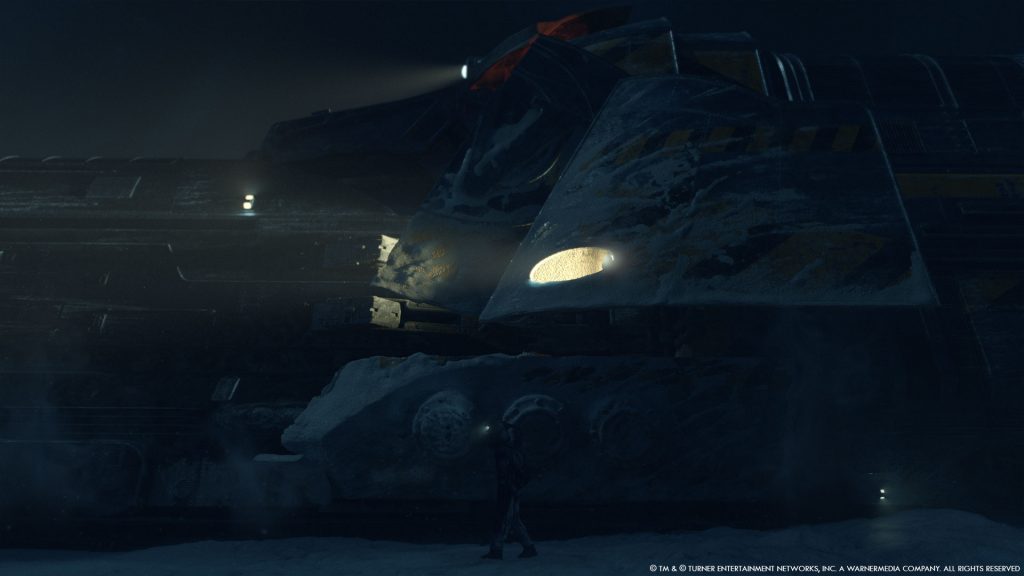
What was their approach and expectations about the visual effects?
Initially, for season one the plan was to use visual effects more sparingly. By the end that changed. So, for season two the expectations are immense. But that’s the way it goes, season two the expectations are always double season one.
How did you organize the work with your VFX Producer?
My VFX Producer is Darren Bell. We’ve worked together on and off since 2009. Essentially each season we outline who we want to work with and what the distribution of work would be. We always try to measure where we are and assess ways to try and improve.
What are the main changes you have made since the first season?
Season 2 the use of our train is more story driven. In season one we’d often use the train as a means to establish where we were in the world. In season two the train is often pivotal to the story telling.
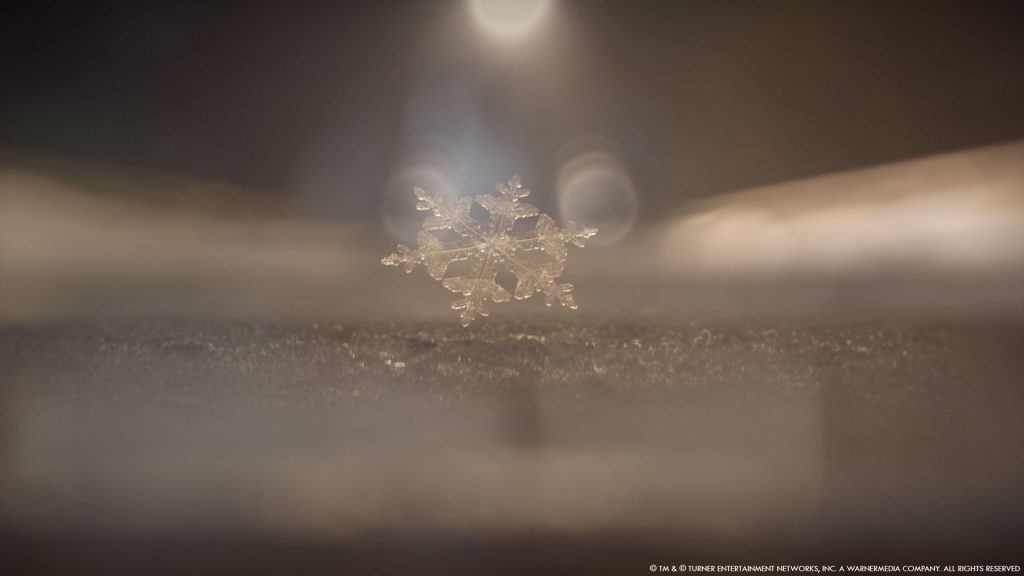
Can you explain in detail about the creation of the two trains?
When I was initially contacted about Snowpiercer I hired a small design team out of Toronto to put together some concepts. Eventually I hired Alex Nice, an amazing concept artist and he knocked it out of the park on his first pass. When it came to designing Big Alice.
Can you elaborate about the new train?
The new train, Big Alice, was conceived as the prototype for Snowpiercer. She needed to have some aspects that felt inherently Snowpiercer but not be a clone. As for her use she was designed to be a restocking car, many of her cars designed to be more like warehouses on wheels. There’s also the Connector car named so because it was designed to connect onto the tail of Snowpiercer. Our inspiration for how the connector car latched on came from the mouths of the Bobbit Worm and the Sarcastic Fringe head fish. Although it was purpose built and supposed to connect with Snowpiercer, we still wanted it to still have a violent quality when they latched on.
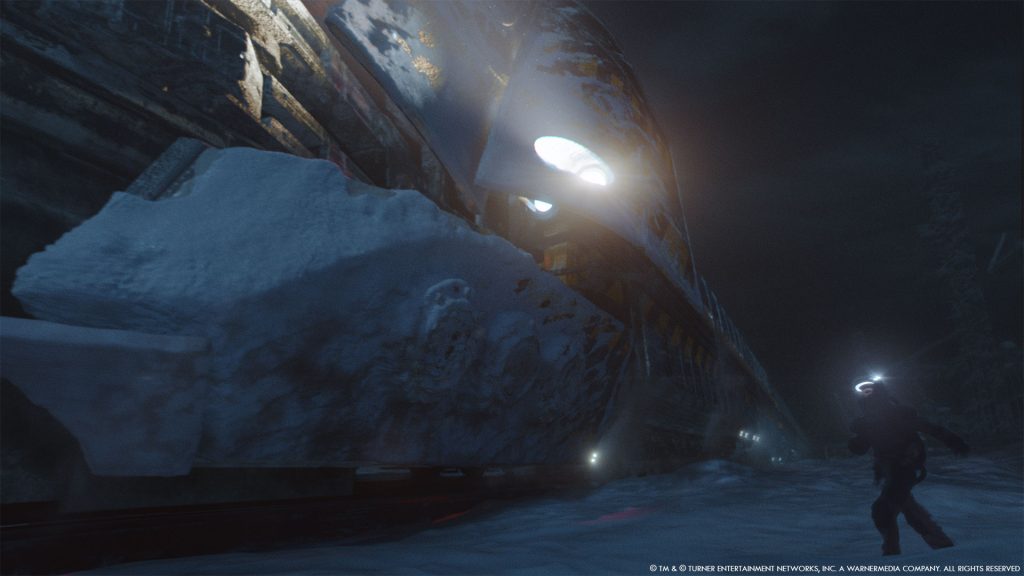
The trains are really long. What was the main challenges with so many train cars?
Scale. Scale is the biggest challenge. It’s very hard to get your head around just how long the train actually is. Our train is so long that we have to take into things like the curvature of the earth when designing shots. We finally did a shot in season two where you could see the entire length of Snowpiercer and the camera is 35’000 feet in the air.
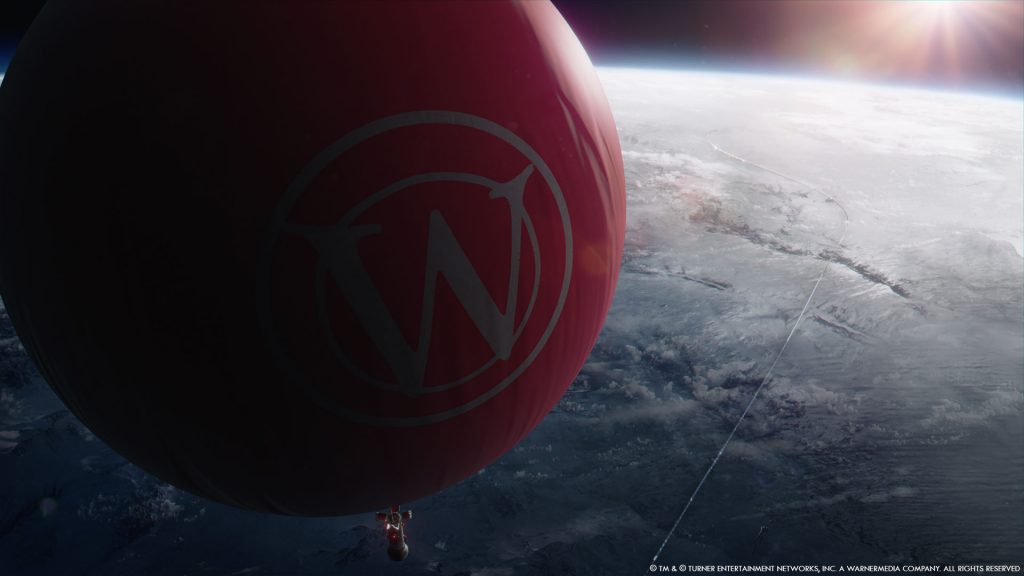
What was your approach to create the massive frozen world?
Biggest challenge for us was to always connect our train to the world that was. Initially we focused on the different types of snow and being geographically accurate but it wasn’t until someone said “I’m missing the connection to the world that was.” (paraphrasing) when the penny dropped. Suddenly I realised it was important that when we saw the world outside of Snowpiercer that we included something from before the world was frozen over.
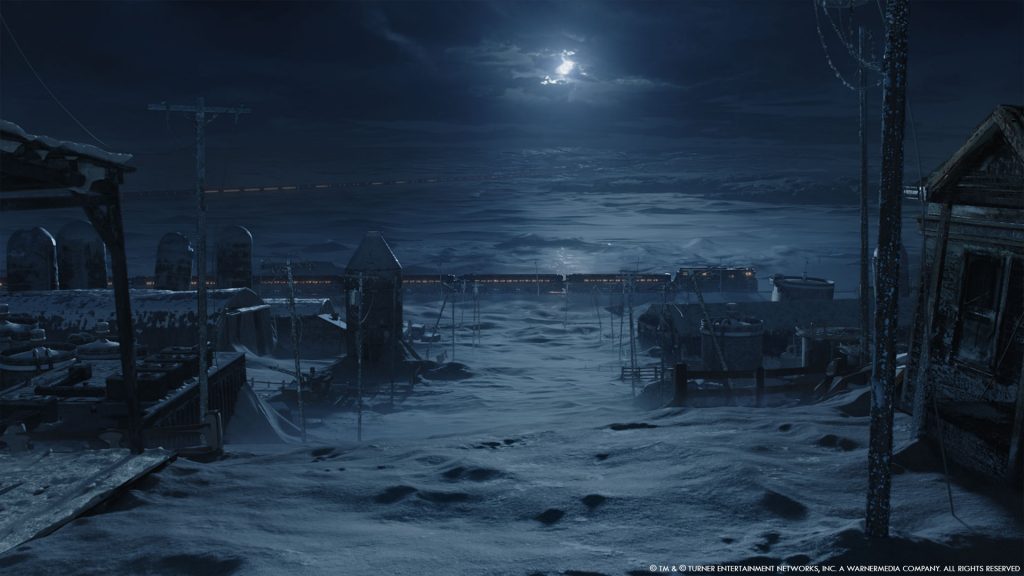
How did you work with the art department to visualize the frozen world?
Graeme and Christoph trust me to design and execute the exterior world. It’s a huge responsibility and privilege.
What was your references and influences for the frozen world?
I’m from Ontario so it comes naturally. All kidding aside we always reference the real world. With climate change being a reality finding reference is, unfortunately fairly straight forward. Extreme weather and areas covered in snow that shouldn’t be are becoming a regular occurrence.
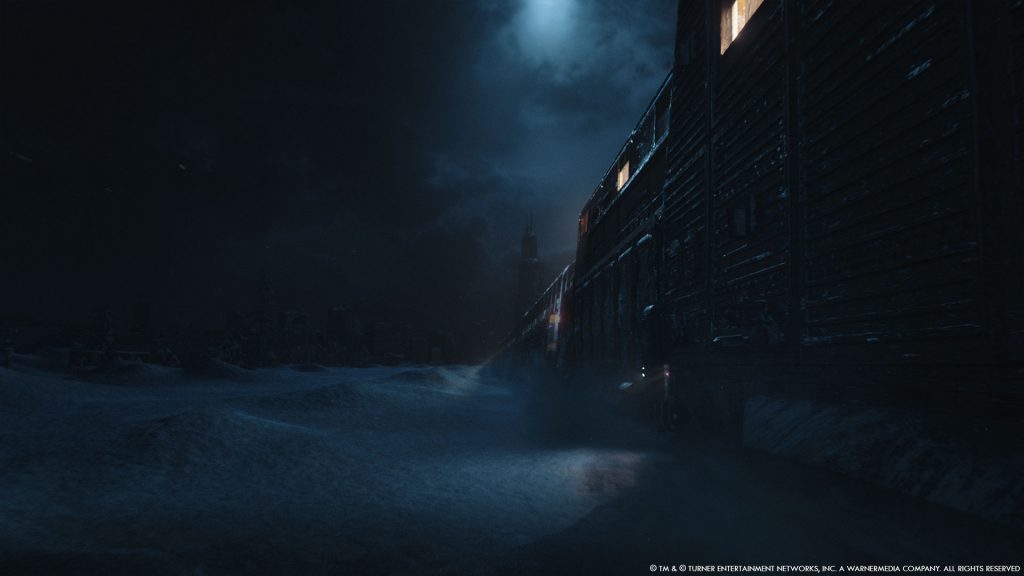
Which location was the most complicated to create and why?
We always try to incorporate real world locations into our shots. In season 2 we were tasked to find a volcano in a very specific part of the world. Our producing director Christoph Schrewe was the real hero and found a location that is perfect.
How did you handle the challenge with the harsh daylight on the frozen world?
We just made sure we referenced the real world. Often the urge is to go very blue with a shot to emphasise the cold. In reality more often the coldest days are bright and have very yellow, warm sunlight.
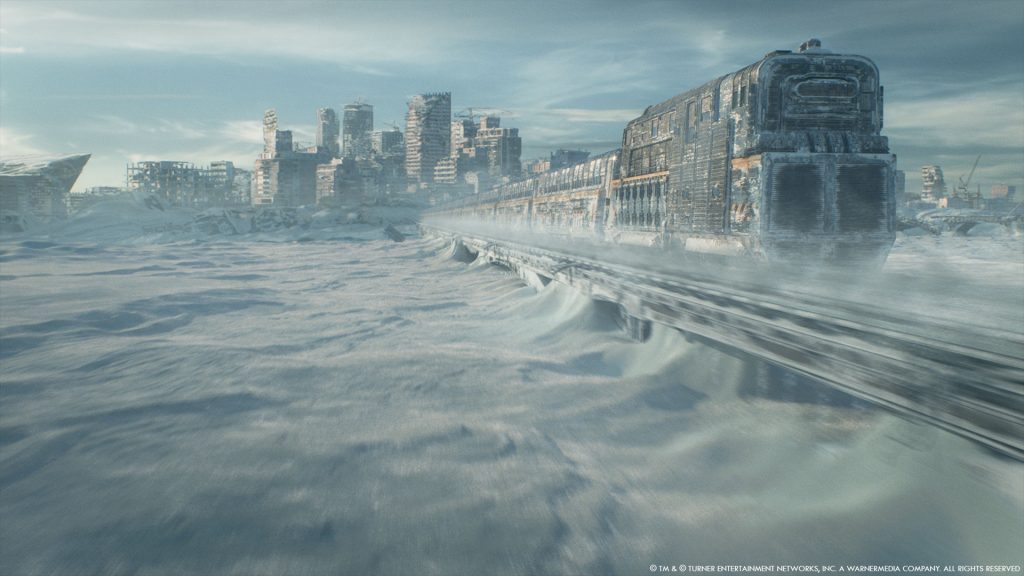
Which sequence or shot was the most challenging?
The opening sequence was very challenging. We had a lot of close up work with Jennifer Connelly and a fully CG train. While we had a practical set built in the end replaced nearly everything that was filmed with our digital train.
Did you want to reveal any other invisible effects?
We connect the train. Most of our cars are not connected on the set and we use VFX to connect them. So far no one has really noticed them so far and that’s really great.
How did you choose the various vendors?
With FuseFX we had worked with on season one and they came through with some great work. They did a lot of heavy lifting in the end when we were in a bit of a time crunch. So, we had them do more elaborate shots in season 2 which was a great. Image Engine came onboard later on in the season and between their hard surface and work it was an easy choice. They’ve been great too.
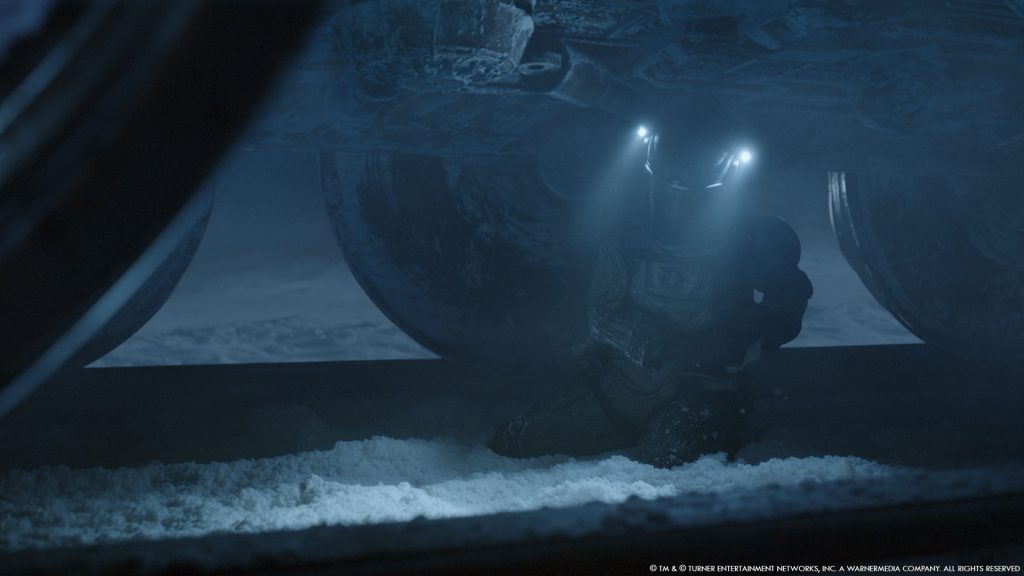
How was the collaboration with their VFX Supervisors?
Great. Both companies were easy to work with. On season one of Snowpiercer I rarely did an in-person meeting with FuseFX, so in our post Covid-19 world the communication flowed effortlessly. As for Image Engine, I one day hope to meet their team in the real world. I’ve had the pleasure of working with them now for approximately 6 months and have no idea what they actually look like.
Is there something specific that gives you some really short nights?
I get a little anxious before filming a big sequence. Especially if it’s something I’ve never filmed before. But I was given some great advice years ago. “Whatever happens here it’s your decision to make, your decision to live with ultimately yours to fix and you can fix anything.” So if I ever get a little stressed I try to remember that conversation.
What is your favorite shot or sequence?
My favorite shot in season 2 comes in episode 10 so I can’t really say what it is yet. But I pitched it to Graeme Manson when we were halfway through post on season 1 and I’m very excited for the audience to see it.
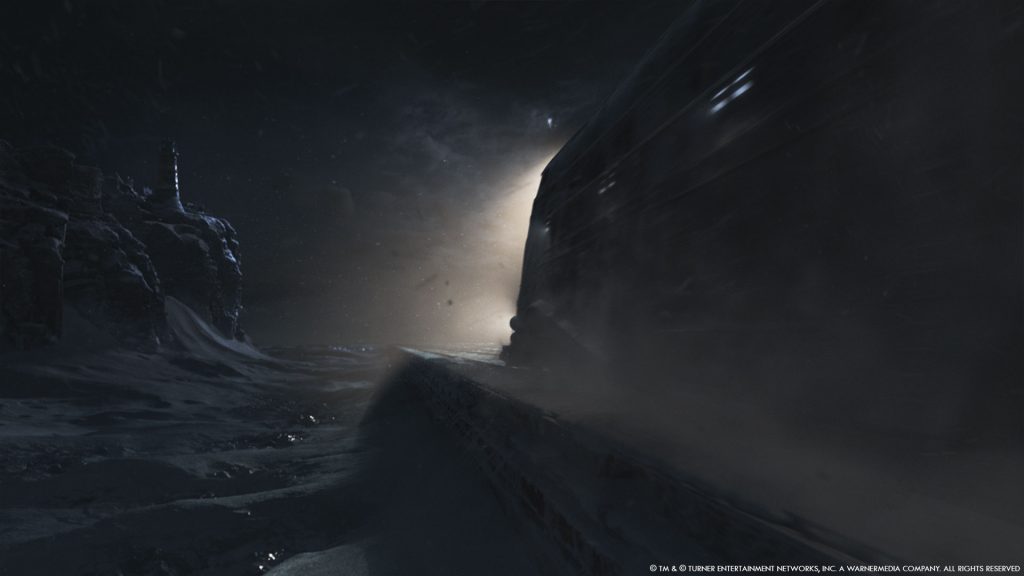
What is your best memory on this show?
To be honest after so many years I have a lot. It’s probably cliché but the comradery I feel for a lot of people on this show is my best memory.
How long have you worked on this show?
I started working on Snowpiercer back in 2019.
What’s the VFX shots count?
Season 2 has approximately 1450 shots.
What was the size of your team?
Internally I have a half dozen artists working for me directly and have employed 4 different companies FuseFX, Torpedo, Mr. X and Image Engine.
What is your next project?
I’m currently prepping Season 3 of Snowpiercer and that is plenty.
What are the four movies that gave you the passion for cinema?
Star Wars: The Empire Strikes Back
Blade Runner
2001: A Space Odyssey
E.T.
A big thanks for your time.
© Vincent Frei – The Art of VFX – 2021
The teams of Sony Pictures Imageworks unveil their work on the Netflix animated movie Over The Moon with this series of breakdown videos:
WANT TO KNOW MORE?
Sony Pictures Imageworks: Dedicated page about Over the Moon on Sony Pictures Imageworks website.
Netflix: You can now watch Over the Moon on Netflix.
© Vincent Frei – The Art of VFX – 2021
Let’s meet the teams of Vancouver based studio Image Engine in a new series of videos:
© Vincent Frei – The Art of VFX – 2021
The Spanish studio El Ranchito takes us to the Galician coast in the 1960s with their work on the drama film El verano que vivimos:
WANT TO KNOW MORE?
El Ranchito: Dedicated page about El verano que vivimos on El Ranchito website.
© Vincent Frei – The Art of VFX – 2021
Elisabetta Rocca has been working at EDI Effetti Digitali Italiani for more than 6 years. She has worked on projects such as The Champion, Shadows and Life in a Year.
Stefano Leoni has been working at EDI Effetti Digitali Italiani for more than 20 years. He has worked on a large number of shows such as American Gods, The Greatest Showman, Ford v Ferrari and ZeroZeroZero.
What is your background?
Stefano // Film making and Computer Animation degrees
Elisabetta // I have a degree in marketing and communication. I approached the world of post production through some work experiences and from that moment I was fascinated by the world of visual effects and have never left it.
How did you and EDI get involved on this show?
Stefano // Thanks to Groenlandia, Matteo Rovere, Sydney Sibilia and Netflix that involved us.
Elisabetta // When Matteo Rovere and Sydney Sibilia started working on the pre-production of the movie, they were looking for a partner to prepare and manage the visual effects part. Given the esteem between EDI and Greenlandia, consolidated thanks to the various projects carried out together, they offered us to join the project and we were immediately fascinated by it. We had also already had the opportunity to collaborate with part of the Netflix team and they too welcomed us into the project with enthusiasm.
How was the collaboration with Director Sydney Sibilia?
Stefano // Great, Sydney is a special and smart director with great skills. He’s really curious to understand how VFX can enhance and help his film.
Elisabetta // Working with Sydney was one of the best things about the project. He has always been present during the development of the VFX process and it is certainly thanks to this synergy that we have obtained an excellent product.
What was their expectations and approach about the visual effects?
Stefano // The approach was to create the Island in open sea and a nice mood about Italy in the 60s, so we worked on several assets to create environments, crowds, cars and props.
Elisabetta // One of the challenges of this movie was to recreate the setting of the film with great historical accuracy. The VFX had to be at the service of the credibility of the story at the time it took place. Even the most spectacular sequences were created always keeping in mind the historical fidelity that was fundamental for Sydney.
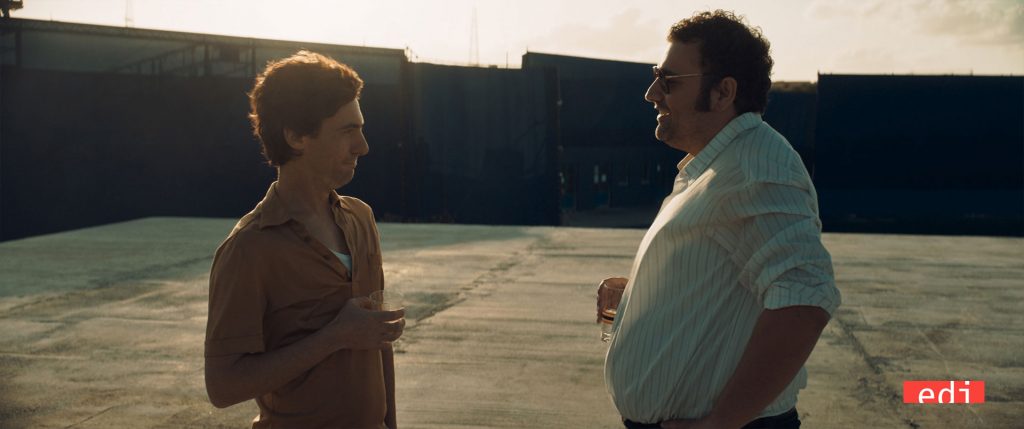
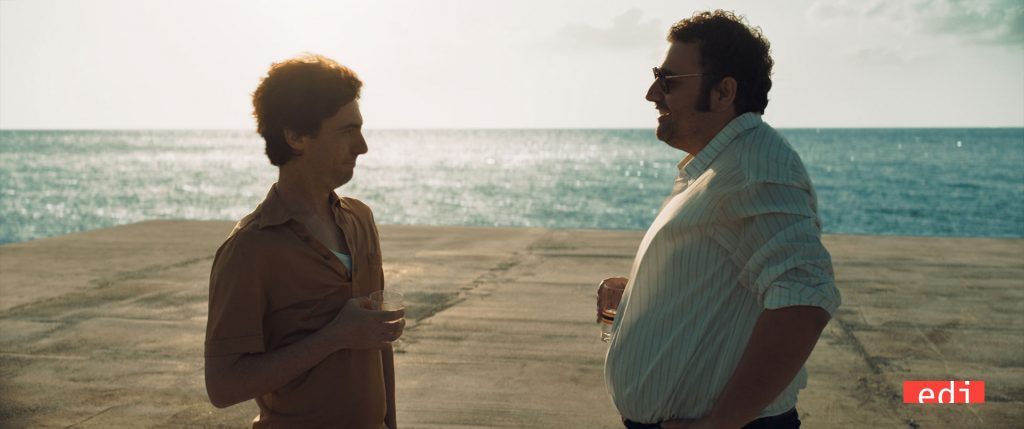
How did you organize the work with your VFX Producer?
Elisabetta // The whole project was based on a great collaboration between the departments that worked side by side in every phase.
How did you split the work between you?
Stefano // I followed Sydney on set supervising and discussing any creative ideas/VFX to make it look real, Elisabetta managed the budget, all the workflow and schedule with the VFX team and the day by day work.
The movie is taking us to various places such as New York, Strasbourg or Imola. Can you explain in detail about the environments work?
Stefano // There was no chance to shoot NY because of the lockdown so we decided to shoot in a parking lot in Rome and build all the 1st av (with cars and crowds) and UN building in CGi.
About Strasbourg we needed to find a town with snow so we moved to Aosta and found a location to extend digitally (Council of Europe).
Imola is my favorite, we did a huge work to represent a Race MotoGp in the 60’s, so we went to shoot in a Circuit nearby Rome and created the whole environment, bikers, crowd and the race crash.
Which place was the most complicate to create and why (beside the island)?
Elisabetta & Stefano // For sure the Imola sequence was the most complex. Starting with the geography of the circuit that had to be built from scratch and had to be clear both for us and for the public. The sequence was shot in a much smaller circuit than the one of Imola and without stands or various furnishings typical of motorcycle racing tracks. Our challenge was to create a much more spectacular setting, giving to the audience points of reference that would make the narrative clear. We started with a shared concept and from there we went to enrich by adding banners, flags, crowds and furnishings of various kinds. All the structures were designed and modeled on the basis of a study on the races of the time. The search for the brands and logos to be used was also very accurate because we needed to have logos of the time consistent with those that could be present in a motorcycle race. Also our 3D department created a crowd asset and related clothes that would give movement and color to the scene by studying the clothing of the time.
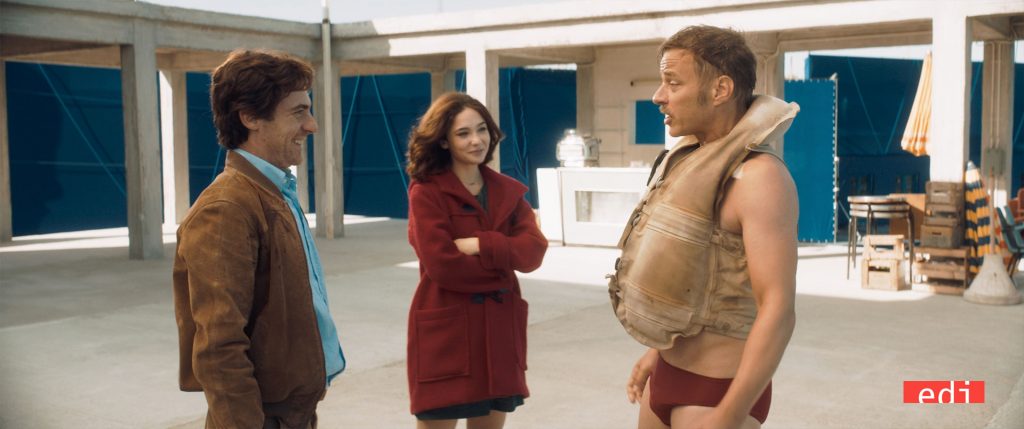
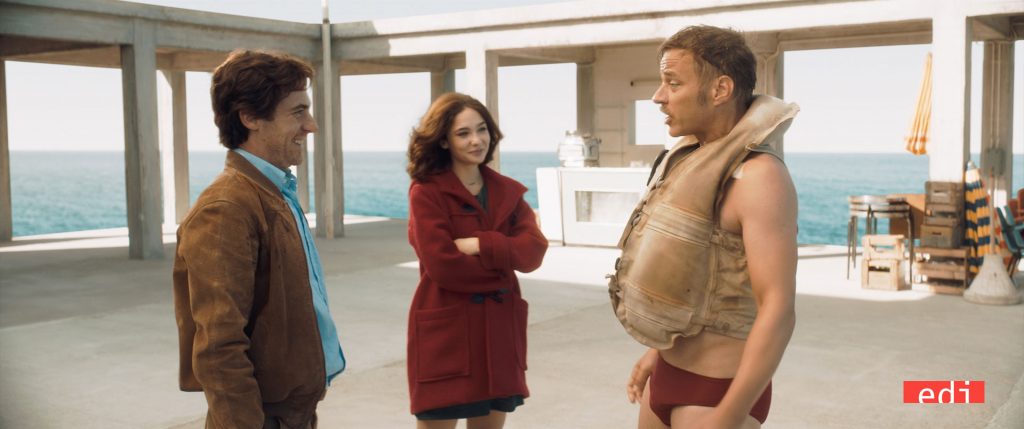
Can you tell us more about the race crash?
Stefano // Race crash was a big challenge, we planned all the layers (about 10) to have them match together. We started from the bike impact, explosion, etc. and proceed layer by layer to compose all the cut. Only the bikers fall is CG.
How did you approach the removal of the anachronisms?
Elisabetta // Removing the anachronisms was a very painstaking job. Together with the production designer Tonino Zera, we identified the elements out of context and with his help we removed them or much more often replaced them with objects in line with time. A street lamp from the 60s is very different from that of today, as well as a window or a door and so on. Attention to these details was very important to the director.
Let’s talk about the famous island. Can you elaborates about its creation?
Elisabetta & Stefano // About the Island, we did a lot of location scouting and brainstorming and we made a VR simulation to understand the right position where to build the Island on Malta’s Pool. Then we made a CG asset for all the set extensions and establishing shots.
The island was actually built in Malta’s studios but to allow easy access to the actors and crew, it was positioned near the edge of the pool. Therefore, while the “open” side of the island was oriented towards the pool and therefore towards the sea, the portico part was very close to the main- land. For this reason, a long blueback structure was built that closed all the arcades towards the land and which allowed us to recreate the sea background to give the effect that the island was in the middle of the open sea.
Furthermore, in the story, the island has various construction phases, starting from a bare platform until the complete construction of the structures is reached. The art department developed a series of drawings of the various phases that were the basis for our modeling for the shots where the is- land was not built, especially the drone shots.
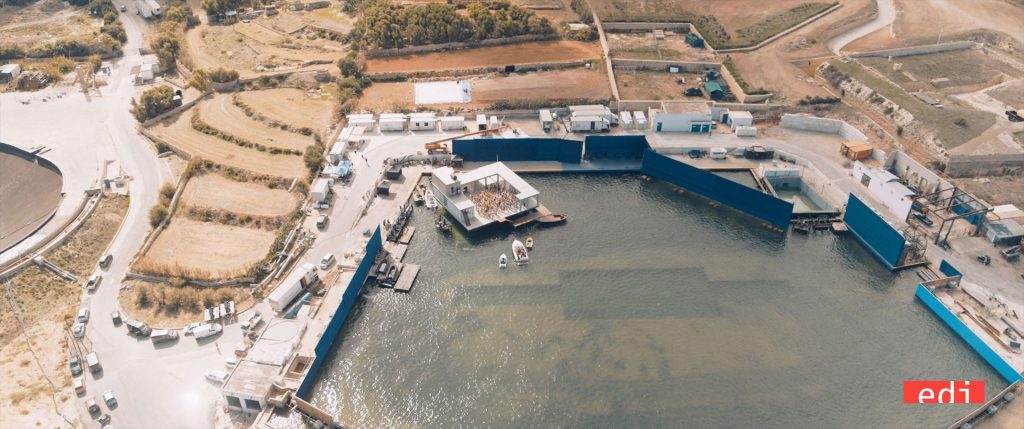
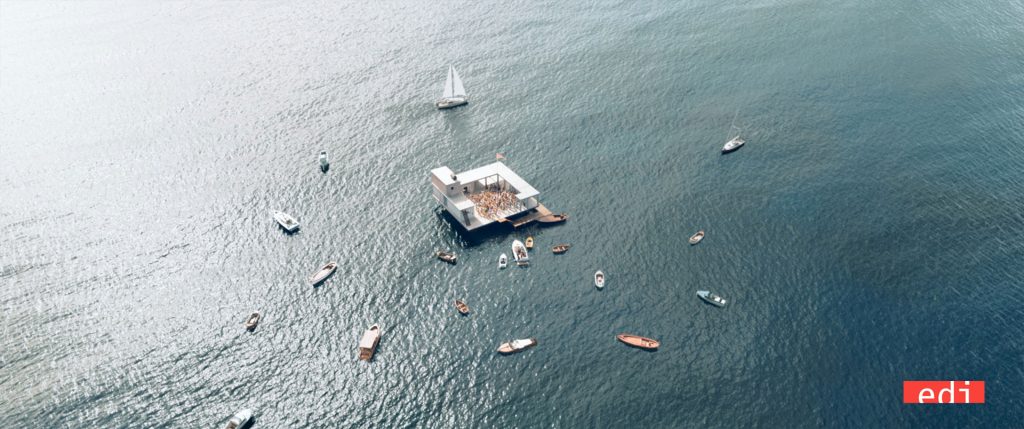
How did you handle the lighting challenges?
Stefano // As said above we planned everything by the VR simulation and the great job by the DP Valerio Azzali
Can you tell us more about the ocean creation and the water simulations?
Stefano // Ocean and water simulation was created by EDI’s FX department and we followed several references to make the sea look real. We shot HDR pictures for every cut to have all the light range.
Elisabetta // In addition to the storm sequence, we created the CG sea for a lot of sequences. As we said before, although the island was built inside a swimming pool overlooking the sea, the boundary between the pool and the sea was still visible so we had to extend the sea in many sequences. To do this we used a mixed technique of compositing of plates shot ad hoc and CGI sea.

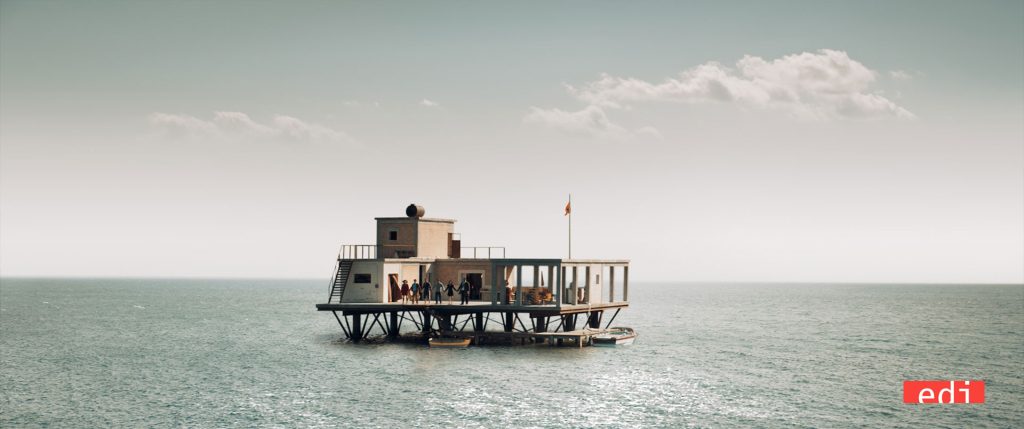
How did you handle the storm sequence?
Stefano // Lots of FX simulations, on set we worked with the Special Effects Supervisor to have interacting practical waves, while all the storm and the sea are CG.
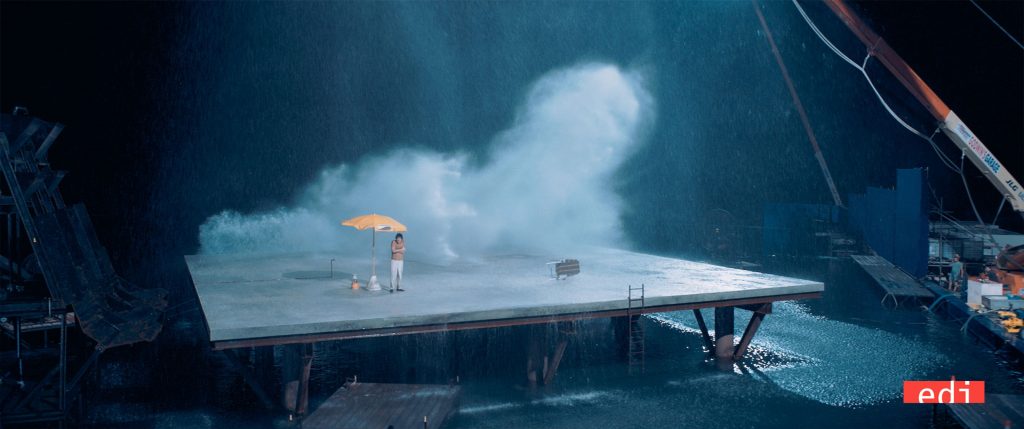
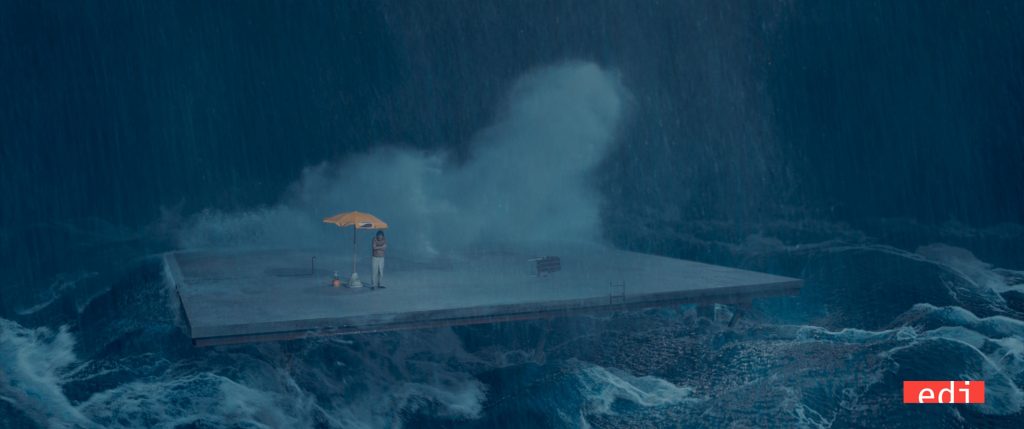
Can you elaborates about the various boats creation and especially the battleship?
Elisabetta // Most of the boats in the movie were made in CGI. Even the Laura Madre, which in many sequences was actually recreated from the set, where it was not possible to film it, has been digitally reconstructed.
As for the warship, the need was to reproduce the Andrea Doria cruiser model of the Italian navy in use in those years. We made use of extensive research of historical material and the support of photographs taken of a model of the ship housed in the aeronautics museum. Once we got all the necessary references, we completely recreated the ship in all the sequences in which it appears. Surely the most important shot of the warship is the first one in which the Andrea Doria is introduced for the first time at sea. Initially this shot was intended as a stock footage but when the editing was completed no material from databases blended well with the mood of the movie. For this reason, with the director we decided to create a full CG shot that showed our ship sailing.
How did you create the final explosion and the smoke?
Stefano // It’s a full CG explosion simulation created by the FX department, we built a CG Island asset and we put forces and explosions as you would do in real life.
Which sequence or shot was the most challenging?
Stefano // Imola’s race.
Elisabetta // There have been many challenging shots but for me certainly the long sequence shot showing the evolution of the island and its construction through a camera movement around the flag was the most challenging. The idea was that through the 360-degree camera movement, a temporal allegory was created that showed how the island was initially empty and a bit rough and then over time became a meeting place for young people, increasingly rich in construction and crowded. Stefano and Sydney had carefully planned this shot. With the help of a 3D animatic that our team made in pre-production, exactly what was planned was shot. However, to recreate the time passage we had to work on every aspect of the shot: sky replacement, revealing the second floor of the island, adding boats and crowds dancing on the island.
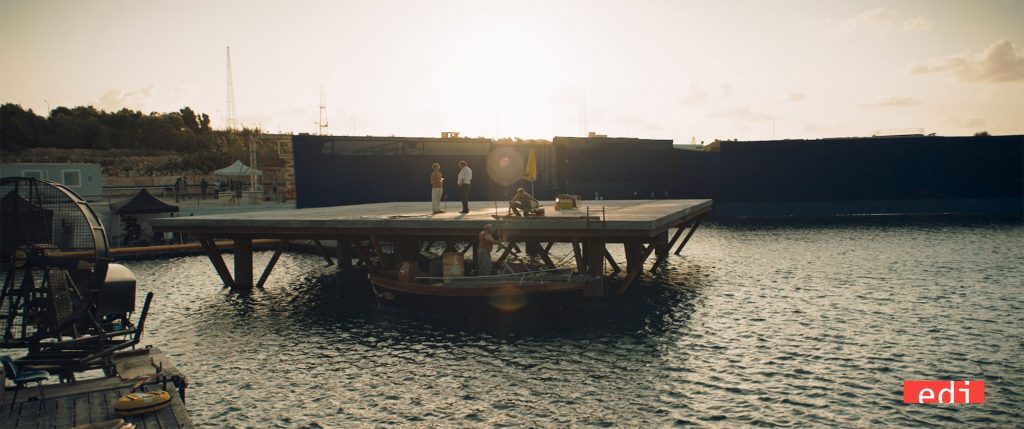
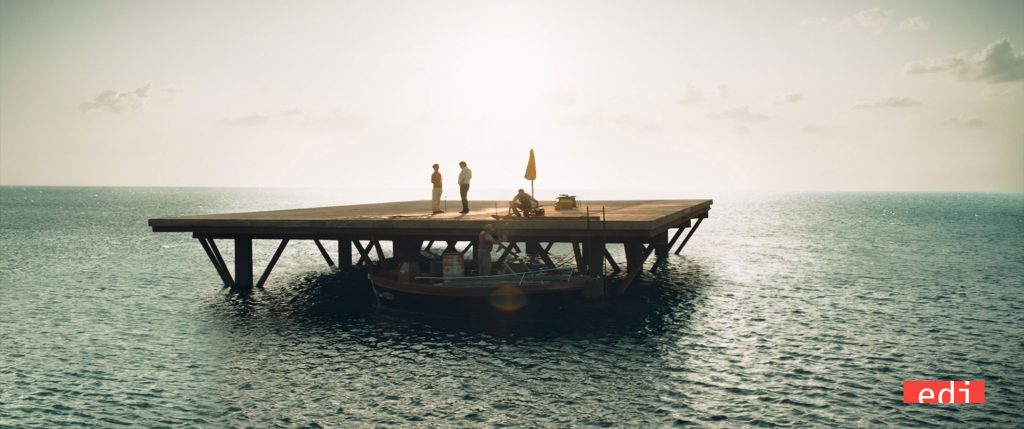
Did you want to reveal to us other invisible effects?
Elisabetta // One of the best rewards once the movie came out on Netflix was talking to a lot of viewers and realizing that many of the effects we made weren’t visible at all and were fully integrated into the narrative.
For example, we have reconstructed the Council of Europe car park that can be seen through the windows using a mixed technique of mattepaint and 3D, or we have modified all the buildings that can be seen along the Rimini coast in various sequences. And so many others.
Stefano // Rimini’s beach and promenade, Bologna’s wedding shop and Vatican’s Garden are in a different location, it’s a huge CG work.
Is there something specific that gives you some really short nights?
Stefano // Lockdown and remote work are a nightmare when you are in crunch time.
Elisabetta // As Stefano says, certainly the fact that most of the work took place during the lockdown meant that we and the team needed some time to organize the work in the best possible way and make it more fluid and this meant a big effort. EDI has equipped itself very quickly to the need to work remotely, providing all its collaborators with the possibility of working via VPN from home on the machines that are physically in the office, guaranteeing data security and the required performances.
Obviously, however, our work is a work of confrontation between artists from various departments and it took a little while to reorganize the team’s synchrony.
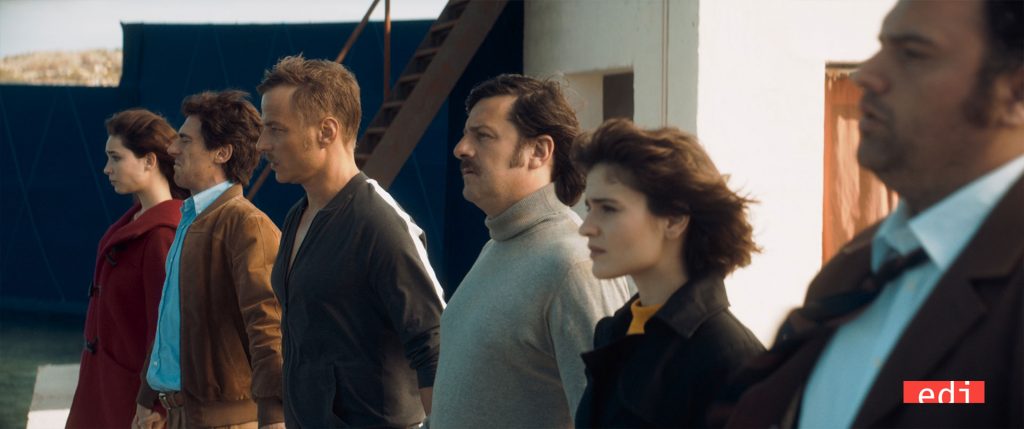
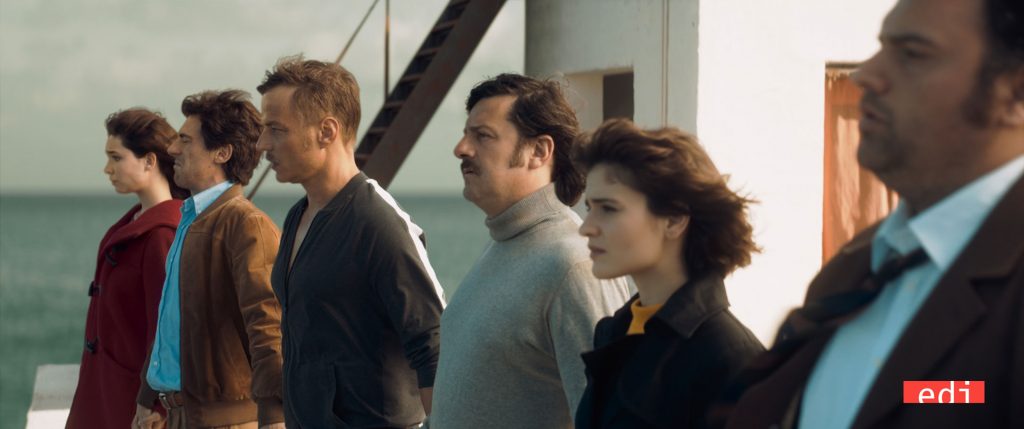
What is your favorite shot or sequence?
Stefano // Imola’s sequence.
Elisabetta // I find it hard to chose a favorite shot but certainly one of those I am most fond of is the one in which Giorgio makes a phone call from a phone booth of a motorway service station. That situation was shot in a large parking lot where there was practically nothing. We have rebuilt both the PAVESI service area (typical of the Italian motorways of the 1960s) and all the cars and petrol stations. This was one of the first shots to be finalized and seeing the result and the director’s enthusiasm when we showed it to him was very nice.
What is your best memory on this show?
Stefano // The amazing Team Work (all the crew) and the big support and suggestions by the director Sydney Sibilia.
Elisabetta // I agree that one of the best things about the project was the great collaboration between all departments, inside and outside EDI.
One of the funniest things in particular was the meetings we had every Friday with all departments, director, producers, set design, dop and us. Due to the health situation these were telematic meetings in which we had the opportunity to discuss all together with great serenity and a spirit of collaboration.
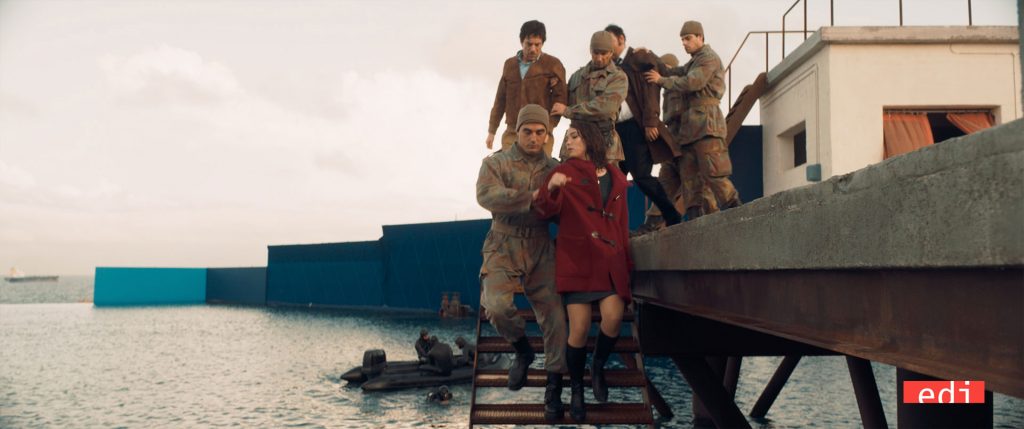
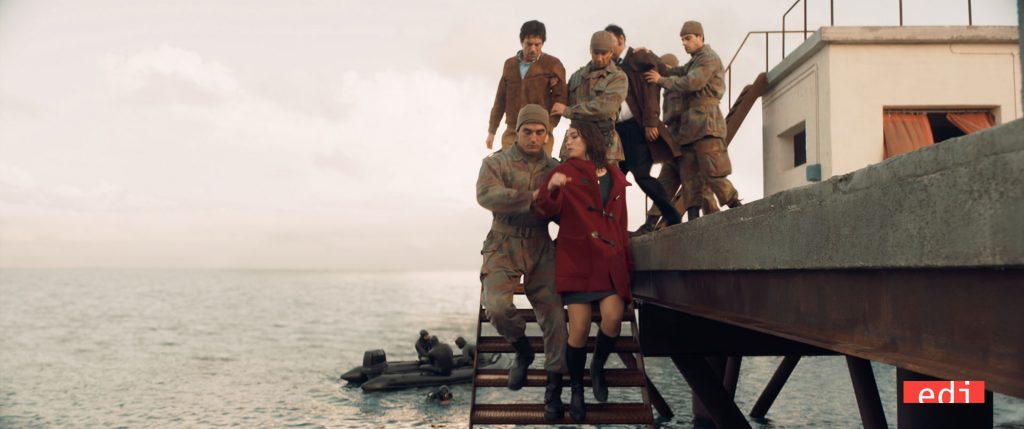
How long have you worked on this show?
Stefano // From pre-production to shooting and VFX production we worked about a year on this project.
What’s the VFX shots count?
Elisabetta // We handled about 650 shots.
What was the size of your team?
Elisabetta // The team consisted of about 50 people including producers, supervisors, compositors, FX artists, lighters and mattepainters. A great team!
What is your next project?
Stefano // I’ve just finished Freaks Out, and I’m moving to TV series projects.
Elisabetta // as Stefano said we have recently closed another very ambitious project called Freaks Out, directed by Gabriele Mainetti. We can’t wait for the theatre to reopen to be able to show you this film too.
What are the four movies that gave you the passion for cinema?
Stefano // A Clockwork Orange, Fight Club, Akira, The Thin Red Line.
A big thanks for your time!
// Rose Island – VFX Breakdown – EDI Effetti Digitali Italiani
WANT TO KNOW MORE?
EDI: Dedicated page about Rose Island on EDI website.
Netflix: You can now watch Rose Island on Netflix.
© Vincent Frei – The Art of VFX – 2021
The BAFTA has just announced the nominees for the EE British Academy Film Awards 2021!
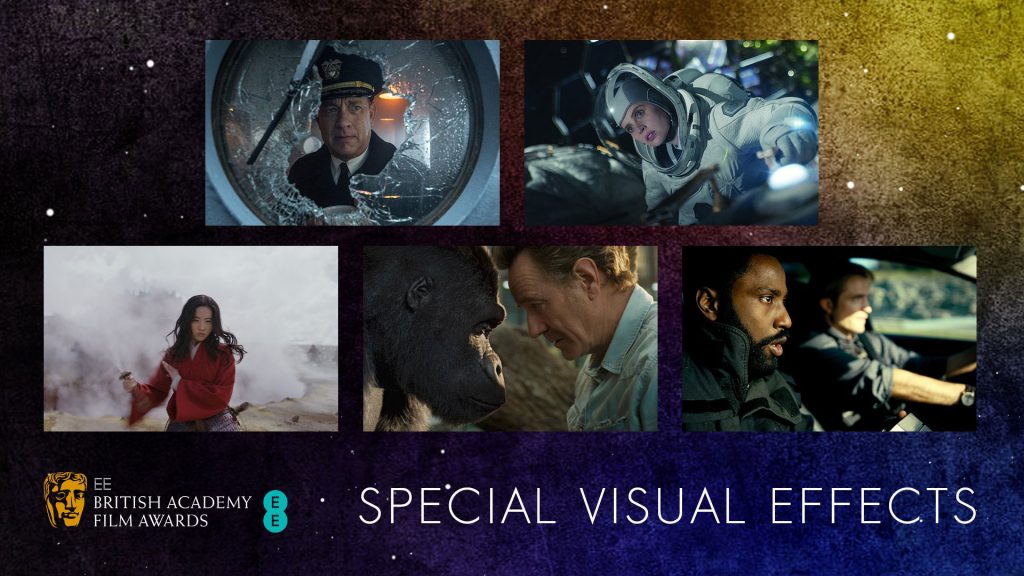
Here are the nominees for Special Visual Effects:
Congratulations to all the nominees!
You can have a look at the complete nominations here.
© Vincent Frei – The Art of VFX – 2021
Method Studios present their work involving biotech killing machine and bionic enhanced mercenary on some crazy action sequences for Bloodshot!
WANT TO KNOW MORE?
Method Studios: Dedicated page about Bloodshot on Method Studios website.
© Vincent Frei – The Art of VFX – 2021
ICYMI in our interview, let’s go for a trip into the Western movie, News of the World, with Outpost VFX presenting their invisible work!
WANT TO KNOW MORE?
Outpost VFX: Dedicated page about News of the World on Outpost VFX website.
Outpost VFX: My interview of Ian Fellows, VFX Supervisor at Outpost VFX.
Netflix: You can watch News of the World on Netflix now (except US, Canada and other select territories).
© Vincent Frei – The Art of VFX – 2021
DNEG present a huge variety of work made for TV such as Altered Carbon, Chernobyl, Cursed and Westworld:
WANT TO KNOW MORE?
Altered Carbon: Dedicated page about Altered Carbon on DNEG website.
Chernobyl: Dedicated page about Chernobyl on DNEG website.
Cursed: Dedicated page about Cursed on DNEG website.
Westworld: Dedicated page about Westworld on DNEG website.
© Vincent Frei – The Art of VFX – 2021